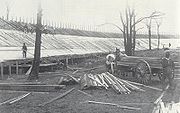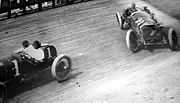
Board track racing
Encyclopedia



Motorsport
Motorsport or motorsports is the group of sports which primarily involve the use of motorized vehicles, whether for racing or non-racing competition...
popular in the United States
United States
The United States of America is a federal constitutional republic comprising fifty states and a federal district...
between the second
1910s
File:1910s montage.png|From left, clockwise: The Model T Ford is introduced and becomes widespread; The sinking of the R.M.S. Titanic causes the deaths of nearly 1,500 people and attracts global and historical attention; Title bar: All the events below are part of World War I ; French Army lookout...
and third
1920s
File:1920s decade montage.png|From left, clockwise: Third Tipperary Brigade Flying Column No. 2 under Sean Hogan during the Irish Civil War; Prohibition agents destroying barrels of alcohol in accordance to the 18th amendment, which made alcoholic beverages illegal throughout the entire decade; In...
decades of the 20th century. Competition was conducted on oval race courses with surfaces composed of wooden planks
Lumber
Lumber or timber is wood in any of its stages from felling through readiness for use as structural material for construction, or wood pulp for paper production....
. Although the tracks most often used by motorcycles, many different types of racing automobiles also competed, enough so as to see the majority of the 1920s American national championship
American Championship Car Racing
Since 1916 there has been a recognized United States national automobile racing National Championship for drivers of professional-level, single-seat open wheel race cars. The championship has been under the auspices of several different sanctioning bodies since 1909. Since 1911, the Indianapolis...
races contested at such venues.
By the early 1930s, board track racing had fallen out of favor, and into eventual obsolescence, due to both its perceived dangers and the high cost of maintenance of the wooden racing surfaces. However, several of its most notable aspects have continued to influence American motorsports philosophy to the present day, including: A technical emphasis on raw speed produced by the steep inclinations; ample track width to allow steady overtaking between competitors; and the development of extensive grandstands surrounding many of the courses.
History
The first board track opened at the Los Angeles Coliseum Motordome near Playa del Rey, California, on April 8, 1910. Based on and utilizing the same technology as the French velodromeVelodrome
A velodrome is an arena for track cycling. Modern velodromes feature steeply banked oval tracks, consisting of two 180-degree circular bends connected by two straights...
s used for bicycle races, the track and others like it were created with 2 inches (50.8 mm) x 4 inches (101.6 mm) boards, and banked up to 45°, and some venues, such as Fulford-by-the-Sea and Culver City
Culver City, California
Culver City is a city in western Los Angeles County, California. As of the 2010 census, the city had a population of 38,883, up from 38,816 at the 2000 census. It is mostly surrounded by the city of Los Angeles, but also shares a border with unincorporated areas of Los Angeles County. Culver...
, boasting unconfirmed higher bankings of 50° or more. Around a half dozen tracks up to two miles (3 km) long had opened by 1915. By 1931 there were 24 operating board tracks, including tracks in Beverly Hills, California
Beverly Hills Speedway
Beverly Hills Speedway was an American board track in Beverly Hills, California, USA. It was the home to speeding Model Ts and airplanes which cut through the airspace of Beverly Hills during the roaring 20s. Built in 1919 on what is currently the site of the Beverly Wilshire Hotel and many shops...
, Atlantic City, New Jersey
Atlantic City, New Jersey
Atlantic City is a city in Atlantic County, New Jersey, United States, and a nationally renowned resort city for gambling, shopping and fine dining. The city also served as the inspiration for the American version of the board game Monopoly. Atlantic City is located on Absecon Island on the coast...
, Brooklyn, New York, and Laurel, Maryland
Laurel, Maryland
Laurel is a city in northern Prince George's County, Anne Arundel County, and Howard County, Maryland, United States, located midway between Washington, D.C. and Baltimore. Incorporated in 1870, the city maintains a historic district including its Main Street...
. The board tracks popped up because of the ease of construction and the low cost of lumber.
The end of board tracks
Traditionally, the banking angle in the corners of board tracks began at 25° (first utilized in 1911). The banking angle was increased later to 60°. The effect of this change resulted in higher cornering speed and higher G-forceG-force
The g-force associated with an object is its acceleration relative to free-fall. This acceleration experienced by an object is due to the vector sum of non-gravitational forces acting on an object free to move. The accelerations that are not produced by gravity are termed proper accelerations, and...
on drivers. Fans sat on the top of the track looking down at the racers. When a driver lost control of a racecar in a corner, he could slip up off the track and into the crowd. Many fatalities occurred, often involving numerous spectators. The velodrome
Velodrome
A velodrome is an arena for track cycling. Modern velodromes feature steeply banked oval tracks, consisting of two 180-degree circular bends connected by two straights...
at Nutley, New Jersey
Nutley, New Jersey
2010 Census Data:*TOTAL: 28,370 or 100%*White: 23,405 *African American: 628 *Asian: 2,824 *American Indian and Alaska Native: 36 *Native Hawaiian and Pacific Islander: 4...
, a 1/8 mi oval banked at 45° (generating lap times of 8 seconds or less) and built from 1 by 12 in (25.4 by 304.8 mm) lumber on edge, was "unquestionably the deadliest". On September 8, 1912, Eddie Hasha
Eddie Hasha
Eddie Hasha was an American motorcycle racer on board tracks early in the twentieth century. His death contributed to the demise of the board tracks. He was nicknamed the "Texas Cyclone" since he was from Waco, Texas, USA....
was killed at the New Jersey Motordrome near Atlantic City. The accident killed 4 boys and injured 10 more people. The deaths made the front page of the New York Times. The press started calling the short 1/4 and 1/3 mile circuits "murderdromes". The 1913 motorcycle championship races were moved to a dirt track
Dirt track racing
Dirt track racing is a type of auto racing performed on oval tracks. It began in the United States before World War I and became widespread during the 1920s and 30s. Two different types of racecars predominated—open wheel racers in the Northeast and West and stock cars in the South...
because dirt was safer. The national organization overseeing motorcycle racing on board tracks banned all competitions on board tracks shorter than 1 miles (1.6 km) in 1919.
One of the most famous and largest board tracks was located in Uniontown, Pennsylvania during the coal boom. The 1913 - 1915 Summit Mountain Hill Climbs were outlawed, so coal barons and the wealthy of the day came together to build their playground. Carl Laemmle, Universal Films President, sponsored a $3,000. solid silver, 3 foot tall Universal Tropphy Cup in 1916. From 1916 through 1922 Oldfield, the Chevrolet brothers, silent film stars including Vivian Prescott.
Board tracks slowly faded away in the 1920s and 1930s, though racing continued into 1940 at Coney Island Velodrome
Coney Island Velodrome
The Coney Island Velodrome was a mid-sized sports arena in the Coney Island section of Brooklyn in New York City, USA. Designed as a bicycle racing venue, the drome featured a 1/8-mile wooden oval track with 45-degree banked corners and seating for 10,000. It also hosted outboard midgets into 1939...
, Nutley, and Castle Hill Speedway in the Bronx. Notable driver fatalities on board tracks included four Indianapolis 500
Indianapolis 500
The Indianapolis 500-Mile Race, also known as the Indianapolis 500, the 500 Miles at Indianapolis, the Indy 500 or The 500, is an American automobile race, held annually, typically on the last weekend in May at the Indianapolis Motor Speedway in Speedway, Indiana...
winners, three of which occurred at the Altoona course in Tipton
Tipton, Pennsylvania
Tipton is a census-designated place in Blair County, Pennsylvania, United States. The population was 1,225 at the 2000 census. It is well known for its amusement park, DelGrosso's, formerly known as Bland's Park...
, Pennsylvania
Pennsylvania
The Commonwealth of Pennsylvania is a U.S. state that is located in the Northeastern and Mid-Atlantic regions of the United States. The state borders Delaware and Maryland to the south, West Virginia to the southwest, Ohio to the west, New York and Ontario, Canada, to the north, and New Jersey to...
, and three in the same years in which the driver won at Indianapolis. 1919
1919 Indianapolis 500
Results of the 1919 Liberty Sweepstakes held at the Indianapolis Motor Speedway on Saturday, May 31, 1919....
"500" winner Howdy Wilcox
Howdy Wilcox
Howard Samuel Wilcox was an American racecar driver active in formative years of auto racing.Born in Crawfordsville, Indiana, Howdy Wilcox led the last 98 laps of the 1919 Indianapolis 500 after starting in the 2nd position. He died in a wreck in 1923 at the Altoona Speedway board track in Tyrone,...
died in an Altoona race on September 4, 1923, while co-1924
1924 Indianapolis 500
Results of the 1924 Indianapolis 500 held at the Indianapolis Motor Speedway on Friday, May 30, 1924....
winner Joe Boyer
Joe Boyer
Joe Boyer was a co-winner of the 1924 Indianapolis 500. Boyer was born in Detroit, Michigan.At the 1924 Indianapolis 500, Boyer participated in two different cars during the race. In his original entry , he qualified 4th. On the 109th lap he was relieved. His relief driver went on to race until...
and 1929
1929 Indianapolis 500
Results of the 1929 Indianapolis 500 held at the Indianapolis Motor Speedway on Thursday, May 30, 1929.*Ray Keech reigned as champion for only 17 days; he was killed at Altoona Speedway June 15, 1929....
winner Ray Keech
Ray Keech
Ray Keech was a board track and brick track racer in the 1920s. He is best remembered for winning the 1929 Indianapolis 500, and for setting a land speed record.-Land speed record:...
both suffered fatal accidents at the facility in the same years as their 500 wins, Keech's occurring only seventeen days after, on June 15, 1929. Gaston Chevrolet
Gaston Chevrolet
Gaston Chevrolet was a French-born American racecar champion driver and automobile manufacturer.-Early life:...
, winner of the 1920 Indianapolis 500
1920 Indianapolis 500
Results of the 1920 Indianapolis 500 held at the Indianapolis Motor Speedway on Monday, May 31, 1920....
, perished that same autumn, on November 25, 1920, at a Thanksgiving Day race at the Beverly Hills Speedway.
Another contributor to the demise of board tracks was the expensive upkeep. Tracks needed new 2x4 boards every five years. During the last decade of board tracks, carpenters would repair the track from below after the cars raced down the straightaways at 120 mph (193.1 km/h). A further factor was that as speeds rose, overtaking became increasingly difficult; as long as it held together, the fastest car would almost always win the race. This led to spectators turning their attention to the less-predictable racing taking place on dirt tracks.

